
1806 Campaign
A hussar of Lasalle's "Hellish Brigade" captured
Color of Prussian Queen's Dragoon Regiment - by J. Girbal
French Cavalry Under Napoleon.
The cavalry, artillery and infantry participated in numerous battles and campaigns.
Albert-Jean-Michel de Rocca writes: "The various troops that composed our army, especially the cavalry and infantry, differed extremely in manners and habits. The infantrymen, having only to think of themselves and their muskets, were selfish, great talkers, and great sleepers.
... They were apt to dispute with their officers, and sometimes they were even insolent to
them ... They forgot all their hardships the moment they heard the sound of the enemy's first gun.
Strength and Quality of the French Cavalry
Disaster of 1812 in Russia
1812 Sacred Squadron [Escadron Sacré]
|

Horse Carabiniers
There were only two regiments of horse carabiniers, the 1er and 2e. In 1792 the French Ministry of War ordered that the carabiniers must always be chosen from seasoned and reliable soldiers. They were armed with straight sabers and pistols. (They even briefly became 'Horse Grenadiers'). In 1801 the strongest and tallest men and horses from the dissolved 19e, 20e, 21e and 22e Régiment d'Cavalerie were assigned to the horse carabiniers. Despite the flow of soldiers into their ranks in 1803 the two regiments were only 2 squadrons each. Napoleon strengthened them with young robust recruits and brought their strength to 3 and 4 squadrons. In the ranks of carabiniers alongside the Frenchmen served also quite a few Belgians. The carabiniers fought well in the following campaigns 1805, 1806, 1807 and in 1809. In 1809 with the temporary absence of the Guard cavalry, the 1er Carabiniers formed Napoleon's escort.
In 1809 the carabiniers suffered badly in the hands of
Austrian uhlans and Napoleon ordered to give them armor.
Chlapowski, among others, described this combat: "The cuirassier division arrived, with the brigade of carabiniers at its
head. ... Soon an uhlan regiment in six squadrons trotted up to within 200 paces of the
carabiniers and launched a charge at full tilt.
It reached their line but could not break it, as the second regiment of carabiniers was
right behind the first, and behind it the rest of the cuirassier division. I saw a great many
carabiniers with lance wounds, but a dozen or so uhlans had also fallen." (Chlapowski - "Memoirs of a Polish Lancer" p 60)
Horses and Weapons
Colonels
|
|
Cuirassiers
The 13e Régiment was formed in 1809 from the 1e Provisional Heavy Cavalry Reg. The 14e Régiment was formed in 1810 from the 2e Dutch Cuirassier Reg. In 1812 war this regiment had only 2 squadrons, other squadrons were formed in Holland and became available in 1813. In May 1812 they wore the white old (Dutch) uniforms and the new dark blue (French). Regiment was disbanded in 1814. The 15e Cuirassiers was organized in 1814 in Hamburg from the elements drawn from the 2e, 3e, 4e Cuirassiers, officers were taken from many other regiments and all of them were mixed with big number of recruits. When the officers finally were able to mount one squadron the populace witnessed the warriors sprawled on the ground while their horses galloped away along the streets. They were disbanded in 1814.
There were several cuirassier colonels and senior officers who attained the rank of general
of division (1804-1815): Margaron and Berckheim (1st Regiment), Pully (8th and 10th),
Murat-Sistrieres ?? (9th),Espagne (8th), Nansouty and Doumerc (9th),
l'Herithier (10th), and Fouler (11th).
Horses and Weapons
Uniforms
|
|

Dragoons.
Many individual dragoons were brave. Costello describes another gallant dragoon. "One of their videttes, after being posted facing English dragoon, of the 14th or 16th [Light Dragoon Regiment] displayed an instance of individual gallantry, in which the French, to do them justice, were seldom wanting. Waving his long straight sword, the Frenchman rode within 60 yards of our dragoon, and challenged him to single combat. We immediately expected to see our cavalry man engage his opponent, sword in hand. Instead of this, however, he unslung his carbine and fired at the Frenchman, who not a whit dismayed, shouted out so that every one could hear him, Venez avec la sabre: je suis pret pour Napoleon et la belle France. Having vainly endeavoured to induce the Englishman to a personal conflict, and after having endured two or three shots from his carbine, the Frenchman rode proudly back to his ground, cheered even by our own men. We were much amused by his gallantry, while we hissed our own dragoon ... " (Costello "The Peninsular and Waterloo Campaigns" pp 66-67)
Colonels and senior officers of dragoon regiments who attained the rank of general of division (1804-1815):
Arrighi (1st Regiment), Grouchy (2nd), Wathier (4th), Beaumont, Milhaud and Louis Bonaparte
(5th), Tilly and Fauconnet (6th), Sebastiani (9th), Dejean (11th), St. Sulpice (12th), Roget (13th),
Tilly and Blaniac (14th), Landremont (17th), Lefebvre-Desnouettes (18th), Caulaincourt (19th),
Boussart and Corbineau (20th), Delort (24th), and Ornano (25th).
Horses and Weapons
The dragoons were armed with straight sabers and muskets. Their muskets were longer and had longer range of fire than light cavalry's carbines. While a light cavalryman's eqipment included a carbine sling as a means of keeping his weapon readily available for use, the greater length of musket issued to dragoons made a sling impractical. Thus the stock of the musket was seated in a boot attached to the saddle, and irs barrel restrained by a strap attached to the pommel. When the dragoons expected to go into action they drew sabers and muskets slung on their backs. In 1814 they gave away their long muskets for the infantry.
Sappers
Uniforms
|
|

Lighthorse-Lancers
The Poles were acknowledged to be the finest lancers in Europe and Russia, Prussia and Austria recruited their uhlan units from among the Polish subjects. It was followed by an imitative creation of lancer regiments all across Western Europe (France, Germany and and even the British got around to it after Napoleonic wars).
In 1811 at Albuera the entire brigade of British infantry totally disintegrated after the charge of Vistula Uhlans. The Poles captured several cannons, several Colors and took hundreds of prisoners. The panick stricken redcoats surrendered en masse; they threw down their arms, stripped themselves of their belts and ran to the rear.
Weapons
Horse Chasseurs
The chasseurs thought being equal to hussars. The hussars however thought otherwise. Frequent quarrels arose between the two on the most triffling pretext. The chasseurs were best suited for small warfare. On 8th February 1814 a half squadron of 31er Chasseur captured 150 Austrian infantry near Massimbona. Another squadron captured 300 infantry between Marengo and Roverbella. Even the scouts of the regiment did something to be proud of, they captured an Austrian baggage column, which was moving into Villafranca with its escort. (Nafziger and Gioannini - "The Defense of the Napoleonic Kingdom of Northern Italy, 1813-1814" pp 160-162) There were however also defeats and ambushes. De Rocca writes: "Not far from the village of Mia Casas, the Spaniards had placed several squadrons of their best cavalry in ambush, this chosen cavalry fell unawares upon the chasseurs of our advanced guard, who were marching without order ... Our horsemen were overpowered by numbers ... and, in less than 10 minutes, our enemies completely destroyed upwards of 150 of the bravest of our 10th Regiment. ... We arrived too late; we saw nothing but the cloud of dust at a distance, which the retiring Spaniards left behind them. The colonel of the 10th was endeavouring to rally his chasseurs, and tearing his hair at the sight of the wounded strewed here and there over a pretty considerable space of ground."
Colonels and seniors officers of chasseur regiments who attained the rank of general of division (1804-1815):
Montbrun (1st and 7th Regiment), Sahuc and Excelmans (1st Regiment), Laboissiere and Le Marois (2nd), Latour-Maubourg (3rd),
Hautpoul (6th), Pire and La Grange et de Fourilles (7th), La Baroliere (9th), Ordener and Subervie (10th),
Treillard, Bessieres and Jacquinot (11th), Defrance (12th), Lepic (15th), Durosnel (16th), Colaud and
Murat-Sistrieres, La Coste-Duvivier and Castex (20th), Latour-Mauborg and Bordesseoule (22nd), St.Germaine and Bruyeres
(23rd), Pierre Soult (25th), and Digeon (26th).
In no other branch of cavalry served so many foreigners, six regiments of chasseurs were formed of foreigners:
Uniforms
Weapons
|
|

Hussars
"The last type of horsemen to join the ranks of the French cavalry were hussars, a form of mounted unit composed of Hungarian light cavalry who forged their methods
of combat fighting against the Turks. Hussars were true light cavalry, used best for raiding and scouting.
They rode smaller horses, carried somewhat lighter weapons and curved sabers, and wore costumes typical of their origins.
Proposals for cavalerie hongroise came in 1635,
and by 1637, at least 5 companies of such exotic horsemen showed up on French rolls, but they disappeared with the Peace of the Pyrenees.
The first genuine French hussar regiment was raised in 1692 from Imperial deserters, and by 1710, the French
counted 3 regiments of these often outlandish cavalry, regarded by some more as thieves on horseback than as true
cavalrymen." (Lynn - "Giant of the Grand Siecle" p 492)
He considered himself as better horseman and swordsman than everybody else.
Bragging, smoking a pipe, drinking, and duelling - these were their funs. There was a saying: "The hussars were loved by every wife and
hated by every husband". The hussars liked to sing songs that insulted dragoons and considered themselves distinctly
more dashing than chasseurs. In 1805 at Austerlitz the 2e Hussars captured Allies flag.
The 2e was a famous unit. Raised in 1734 by Count Esterhazy, this regiment too the name Chamborant from its colonel.
"The color of its uniform, a most distinctive chestnut-brown with sky-blue facings and breeches, was reputedly
suggested by Marie Antoinnette who remarked upon the color of the habit of a passing monk when Chamborant
asked what color she would suggest for the uniform of his regiment." (Philip Haythornthwaite)
Senior officers and colonels of hussar regiments who attained the rank of general of division (1804-1815):
de Gau Fregeville and Gerard (2nd), Houssaye, LeBrun, and Le Ferriere-Levesque (3rd), Merlin (4th), Grouchy, Lagrange, Kilmaine, Roche and Pajol
(6th), Rapp and Pierre Colbert (7th), Marulaz (8th), Mermet, Beaumont and Lasalle (10th), and Fournier-Sarloveze (12th).
Although adventure and war were the breath of their nostrils
they were also boasters as no troops are invincible.
In 1807 at Golymin General Lasalle led his legendary "Hellish Brigade" (5e and 7e Hussar
Regiment) against
Russian battery of 12-15 guns. The hussars charged with vigor but
then were abruptly seized with panic. The two regiments turned about and, in an indescribable
disorder officers and men mixed, stampeded back to the rear. "Of the whole brigade only the
elite company of the 7e Hussars, placed immediately behind the generals, remained firmly at
their posts." (Dupont - "La panique de Golymin" Cavaliers d'épopée.) Lasalle was furious.
He rode after them, halted and brought them back. Lasalle kept them within a short range
from the Russian guns as punishment for their earlier behavior. Now nobody dared to leave
his post.
In 1798 the Directorate had 12 hussar regiments.
Uniforms and Weapons
|
|

Best Cavalry Regiments.
The light cavalry enjoyed reputation for bravery and an uninhibited joie-de-vivre
when not. There were many excellent regiments of light cavalry, including the 1er
Husards, 2e Husards, 3e Husards, 1er Chasseurs-a-Cheval, 5e Chasseurs-a-Cheval or any of
the lancer regiments. NCO Guindey of 10e Hussars killed Prince Louis Ferdinand of Prussia.
NCO Pawlikowski of Vistula Uhlans captured Prince Liechtenstein. Between 1809 and 1812 the
Baden, Saxon and Hessian outfits were superb. We have selected several units for their
achievements on the battlefield, awards and number of battles during the Empire
(1804-1815).
1er Regiment de Vistule Lanciers (In 1811 the "Vistula Uhlans" were renamed to 7e Lanciers)
7e Regiment de Hussards(part of the legendary "Hellish Brigade")
5e Regiment de Hussards (part of the legendary "Hellish Brigade")
5e Regiment de Chasseurs-à-Cheval
23e Regiment de Chasseurs-à-Cheval
(Battle record and colonels from the period of 1805-15 only)
1er Regiment de Carabiniers-à-Cheval
5e Regiment de Cuirassiers
8e Regiment de Cuirassiers
11e Regiment de Dragons
20e Regiment de Dragons
|
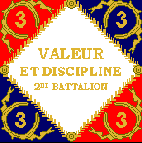
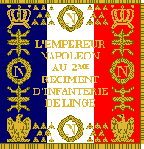
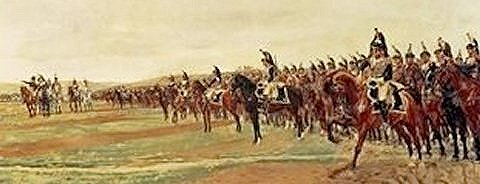 "Cavalry is useful before, during and after the battle," wrote Napoleon, and he stressed the need for audacity in its employment
and careful training to achieve true discipline.
He was also insistent that careful categorization according to role was of great importance...
It was some time before the French cavalry reached its full potential, as it had suffered the loss of many officers during the Revolutionary period, but by 1807 it was reaching its prime. The great charges led by Murat at Eylau and
Grouchy at Friedland played vital parts in the outcome of these battles."
(Chandler - "Dictionary of the Napoleonic Wars" pp 85-86)
"Cavalry is useful before, during and after the battle," wrote Napoleon, and he stressed the need for audacity in its employment
and careful training to achieve true discipline.
He was also insistent that careful categorization according to role was of great importance...
It was some time before the French cavalry reached its full potential, as it had suffered the loss of many officers during the Revolutionary period, but by 1807 it was reaching its prime. The great charges led by Murat at Eylau and
Grouchy at Friedland played vital parts in the outcome of these battles."
(Chandler - "Dictionary of the Napoleonic Wars" pp 85-86)
 The French cavalry was led by Marshal Joachim Murat. His father was farmer-inkeeper, his mother a pious woman set on making a priest
of him. Murat was tall, athletic with a handsome face framed by dark curls. He was "woman-crazy; Napoleon complained that he needed them like he needed food."
(Elting, - p 144) From his first thundering charges on the plains of Italy to his last grand charge at Leipzig,
no commander more epitomized the dash and ambition of the French cavalry than Murat.
He was the embodiement of the cavalryman. Murat habitually led in the very forefront of the charge,
and his presence elicited courage and devotion from his troops. His flamboyant and colorful
outfit, his bravery, and his fun-loving nature was all that many daring European cavalry leaders aspired to be.
His love of war and glory made him the very incarnation of cavalryman.
In combat Murat is supreme. Britten-Austin writes: "Riding out in front of a line of red and white pennons which stretches
from the Dwina's swamp on the right to the island of forest in the centre, he intends to harangue the Polish lancer division
- but finds himself in a most awkward, not to say comical position. The Poles need no
exhortion. With tremendous elan, like several thousand pig-stickers, they charge, driving the King
of Naples like a wild boar before them. And Murat, unable to see or command, has no option but to 'lead' them ...
Only thanks to his Herculean physique and the prowess of his gilded scimitar does he survive in the ensuing
scrum." (Britten-Austin - "1812 The March on Moscow" p 134)
The French cavalry was led by Marshal Joachim Murat. His father was farmer-inkeeper, his mother a pious woman set on making a priest
of him. Murat was tall, athletic with a handsome face framed by dark curls. He was "woman-crazy; Napoleon complained that he needed them like he needed food."
(Elting, - p 144) From his first thundering charges on the plains of Italy to his last grand charge at Leipzig,
no commander more epitomized the dash and ambition of the French cavalry than Murat.
He was the embodiement of the cavalryman. Murat habitually led in the very forefront of the charge,
and his presence elicited courage and devotion from his troops. His flamboyant and colorful
outfit, his bravery, and his fun-loving nature was all that many daring European cavalry leaders aspired to be.
His love of war and glory made him the very incarnation of cavalryman.
In combat Murat is supreme. Britten-Austin writes: "Riding out in front of a line of red and white pennons which stretches
from the Dwina's swamp on the right to the island of forest in the centre, he intends to harangue the Polish lancer division
- but finds himself in a most awkward, not to say comical position. The Poles need no
exhortion. With tremendous elan, like several thousand pig-stickers, they charge, driving the King
of Naples like a wild boar before them. And Murat, unable to see or command, has no option but to 'lead' them ...
Only thanks to his Herculean physique and the prowess of his gilded scimitar does he survive in the ensuing
scrum." (Britten-Austin - "1812 The March on Moscow" p 134)
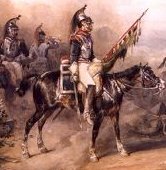 Napoleon's cavalry consisted of the following regiments: 2 horse carabiniers,
12-15 cuirassiers, 15-30 dragoons, 7-9 lancers, 15-31 chasseurs and 7-14 hussars. Two regiments formed
brigade, two brigades formed division and two-five divisions formed corps.
Napoleon's cavalry consisted of the following regiments: 2 horse carabiniers,
12-15 cuirassiers, 15-30 dragoons, 7-9 lancers, 15-31 chasseurs and 7-14 hussars. Two regiments formed
brigade, two brigades formed division and two-five divisions formed corps.
 It is estimated that 175.000 excellent horses of cavalry and artillery
were lost in 1812 in Russia ! The remnants were mounted on Russian and Lithuanian peasant
ponies. The rebuilding of the cavalry in 1813 was more dificult than infantry and artilery.
Shortages of trained cavalrymen, officers, NCOs and war horses were critical.
Promotions were rapidly handed out and temporary squadrons were formed.
It is estimated that 175.000 excellent horses of cavalry and artillery
were lost in 1812 in Russia ! The remnants were mounted on Russian and Lithuanian peasant
ponies. The rebuilding of the cavalry in 1813 was more dificult than infantry and artilery.
Shortages of trained cavalrymen, officers, NCOs and war horses were critical.
Promotions were rapidly handed out and temporary squadrons were formed.
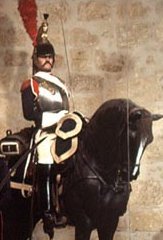 The northern part of France called Normandy was one of the world biggest horse-breeding areas (Studs of Le Pin and St. Lo). Napoleon valued these mounts highly and during reviews often asked colonels how many horses from Normandy they have in their regiments. In 1810 the horse grenadiers of the Guard rode on black horses, 14 1/2 - 15 hands tall, between 4 and 4 1/2 years old and bought in the city of Caen (Normandy) for 680 francs apiece.
The German horse breeders from Hananover and Holstein and traders made fortunes as Napoleon purchased huge amounts of horses for his heavy cavalry. The Prussian large mounts were also accepted.
The northern part of France called Normandy was one of the world biggest horse-breeding areas (Studs of Le Pin and St. Lo). Napoleon valued these mounts highly and during reviews often asked colonels how many horses from Normandy they have in their regiments. In 1810 the horse grenadiers of the Guard rode on black horses, 14 1/2 - 15 hands tall, between 4 and 4 1/2 years old and bought in the city of Caen (Normandy) for 680 francs apiece.
The German horse breeders from Hananover and Holstein and traders made fortunes as Napoleon purchased huge amounts of horses for his heavy cavalry. The Prussian large mounts were also accepted.
 During peacetime the regiments of light and line cavalry had color of horses according to squadron :
During peacetime the regiments of light and line cavalry had color of horses according to squadron :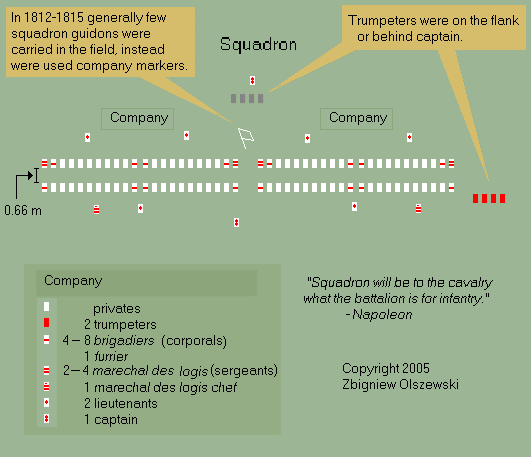
 On picture: French carabinier-a-cheval (horse carabinier).
Museum de'Armee. Oficially the horse carabiniers wore white coats (jackets) but according
to Rousellot (in 'Sabretache' 1987) only their officers wore white coats, the privates wore
light blue ones. Faber du Faur also depicted the horse carabiniers in blue coats
instead of white. According to some sources (for example Coppen) the carabiniers
wore blue at Waterloo. Others claim that they also wore blue during the campaign
in Russia (1812) and white only in the great battle of Borodino.
On picture: French carabinier-a-cheval (horse carabinier).
Museum de'Armee. Oficially the horse carabiniers wore white coats (jackets) but according
to Rousellot (in 'Sabretache' 1987) only their officers wore white coats, the privates wore
light blue ones. Faber du Faur also depicted the horse carabiniers in blue coats
instead of white. According to some sources (for example Coppen) the carabiniers
wore blue at Waterloo. Others claim that they also wore blue during the campaign
in Russia (1812) and white only in the great battle of Borodino.
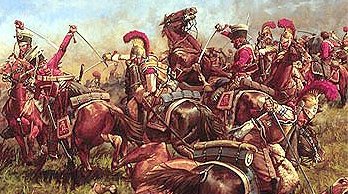 In 1812 at Borodino the carabiniers repeatedly clashed with the Russian cuirassiers, hussars and
dragoons. They fought with gusto until the end of battle when they were defeated by Russian
cuirassiers of the guard (Chevaliers and Horse Guard) and were charged - by mistake -
by French cuirassiers. During the winter retreat from Russia they suffered horrible losses.
The campaign in Russia broke their backbone and they never were the same.
In 1812 at Borodino the carabiniers repeatedly clashed with the Russian cuirassiers, hussars and
dragoons. They fought with gusto until the end of battle when they were defeated by Russian
cuirassiers of the guard (Chevaliers and Horse Guard) and were charged - by mistake -
by French cuirassiers. During the winter retreat from Russia they suffered horrible losses.
The campaign in Russia broke their backbone and they never were the same.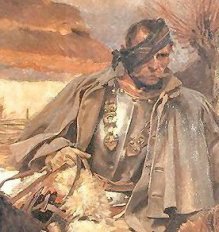 While other types of cavalry had their important roles to play,
it was the cuirassiers, the descendants of the medieval knights, who could turn
a battle with their sheer weight and brute force. They looked dangerous everytime
they ventured forward and the generals never employed them frivolously.
When it came to hardware the cuirassiers were riding arsenals: body armor, helmets,
carbines, pistols and long straigh sabers. The Russians called them zheleznye ludi (the iron men)
While other types of cavalry had their important roles to play,
it was the cuirassiers, the descendants of the medieval knights, who could turn
a battle with their sheer weight and brute force. They looked dangerous everytime
they ventured forward and the generals never employed them frivolously.
When it came to hardware the cuirassiers were riding arsenals: body armor, helmets,
carbines, pistols and long straigh sabers. The Russians called them zheleznye ludi (the iron men)
 The most known cuirassier commanders were Generals Nansouty and d'Hautpoul.
Nansouty came from aristocracy, went with the Revolution but did not put himself forward.
Nansouty was a man of tradition, education and exactitude. "His men were always carefully trained and cared for. Yet there was no elan in his character, no readiness
for an unexpected, all-out blow to save a desperate day. His disposition was mordant ... " (Elting, - p 162)
The most known cuirassier commanders were Generals Nansouty and d'Hautpoul.
Nansouty came from aristocracy, went with the Revolution but did not put himself forward.
Nansouty was a man of tradition, education and exactitude. "His men were always carefully trained and cared for. Yet there was no elan in his character, no readiness
for an unexpected, all-out blow to save a desperate day. His disposition was mordant ... " (Elting, - p 162)
 D'Hautpoul (1754-1807) was a giant of a man, with enormous body strength.
He was a self-confident and very proud individual.
In contrast to Nansouty, d'Hautpoul was a fiery commander eager to charge at any time.
In 1794 at Aldenhoven he crushed enemy cavalry twice as numerous and was promoted to the rank of general.
In 1806 at Jena Hautpoul led the 2nd Cuirassier Division (1st, 5th and 10th Cuirassiers).
In 1807 at Eylau the giant man led his armored cavalry against Russian infantry and artillery.
Jean-Joseph-Ange d'Hautpoul was struck by a Russian cannonball, which dented his armor and shattered his hip. He was taken
wrapped in his bloodstained cloak to the nearby village where he died the following day.
D'Hautpoul (1754-1807) was a giant of a man, with enormous body strength.
He was a self-confident and very proud individual.
In contrast to Nansouty, d'Hautpoul was a fiery commander eager to charge at any time.
In 1794 at Aldenhoven he crushed enemy cavalry twice as numerous and was promoted to the rank of general.
In 1806 at Jena Hautpoul led the 2nd Cuirassier Division (1st, 5th and 10th Cuirassiers).
In 1807 at Eylau the giant man led his armored cavalry against Russian infantry and artillery.
Jean-Joseph-Ange d'Hautpoul was struck by a Russian cannonball, which dented his armor and shattered his hip. He was taken
wrapped in his bloodstained cloak to the nearby village where he died the following day.
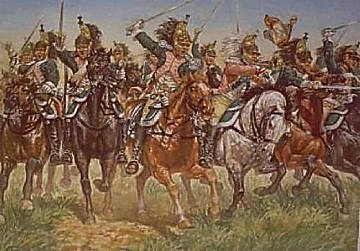 In 1799-1800 France had 20 dragoon regiments.
In 1799-1800 France had 20 dragoon regiments. Napoleon could mount only part of his dragoons. That fact, combined with Napoleon's modern ideas
of combining fire power and mobility, led him to the conclusion that units of foot dragoons
should be formed. For his planned cross-Channel invasion of England, he organized two divisions of dismounted dragoons.
They were put into infantry-style shoes, gaiters and packs. They also received drums to supplement
their trumpets. Colonel Elting writes: "The assignement was sensible, but troopers caught up in the shuffle remembered that veteran dragoons, who hadn't walked farther in years than
the distance from their barracks to the nearest bar, ended up in the dismounted units, while their mounts were assigned to raw recruits.
The results were rough on everybody: hospitals filled up with spavined veterans, recruits got saddle sores.
Also, J.A. Oyon wrote gleefully, matters turned ugly when mounted and dismounted elements of several regiments
bivouaced together. The limping veterans crowded over to check on their old horses and found them
neglected, sore-backed, and lame.
Napoleon could mount only part of his dragoons. That fact, combined with Napoleon's modern ideas
of combining fire power and mobility, led him to the conclusion that units of foot dragoons
should be formed. For his planned cross-Channel invasion of England, he organized two divisions of dismounted dragoons.
They were put into infantry-style shoes, gaiters and packs. They also received drums to supplement
their trumpets. Colonel Elting writes: "The assignement was sensible, but troopers caught up in the shuffle remembered that veteran dragoons, who hadn't walked farther in years than
the distance from their barracks to the nearest bar, ended up in the dismounted units, while their mounts were assigned to raw recruits.
The results were rough on everybody: hospitals filled up with spavined veterans, recruits got saddle sores.
Also, J.A. Oyon wrote gleefully, matters turned ugly when mounted and dismounted elements of several regiments
bivouaced together. The limping veterans crowded over to check on their old horses and found them
neglected, sore-backed, and lame. 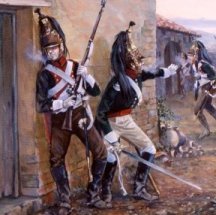 After 1807 majority of the dragoons served on secondary theaters of wars, Spain and Italy.
Many of the regiments in Spain lacked uniforms, horses and equipment. For example in Spain they were dressed in the brown
cloth of the Capucines found in convents and churches. They also had difficulty in obtaining
eppaulettes for their elite companies and chin straps. For lack of sufficient number of
regulation sabers the old Toledo-swords with three edges were used.
But the dragoons were efficient troops. They fought a grim and deadly war of ambush and
retaliation against the hostile Spaniards. They guarded communication lines and escorted convoys.
They also participated in battles with the British and Spanish armies.
After 1807 majority of the dragoons served on secondary theaters of wars, Spain and Italy.
Many of the regiments in Spain lacked uniforms, horses and equipment. For example in Spain they were dressed in the brown
cloth of the Capucines found in convents and churches. They also had difficulty in obtaining
eppaulettes for their elite companies and chin straps. For lack of sufficient number of
regulation sabers the old Toledo-swords with three edges were used.
But the dragoons were efficient troops. They fought a grim and deadly war of ambush and
retaliation against the hostile Spaniards. They guarded communication lines and escorted convoys.
They also participated in battles with the British and Spanish armies.
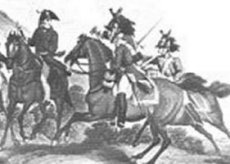 In 1812 the second in command of the British army,
In 1812 the second in command of the British army,  Grouchy, the future marshal, was promoted lieutenant-colonel of the 12th Chasseur-a-Cheval Regiment in 1791.
In 1792 he became colonel of the 2nd Dragoon Regiment (in July he was colonel of 6th Hussar Regiment).
John Elting writes: " [he] was of the ancient chivalry of France,
his family acknowledged aristocracy from at least the 14th Century. ... From the first it was clear that he was 'a horseman by nature and cavalry soldier by instinct.'
Better, he knew how to handle forces of all arms and took good care of his men. When he was suspeneded in 1793 because he was
an aristocrat, his troopers came close to mutiny. ... Grouchy's correspondence shows a thin-skinned man, reluctant to assume
responsibility yet conscientious in discharging it. Actually he was abler than he realized. He failed to show the necessary initiative during Waterloo but, left isolated after that battle, managed a masterful retreat.
As a cavalryman, he was far superior to Murat in tactical skill, administrative ability, and common sense. Clean-handed and very courageous ..."
Grouchy, the future marshal, was promoted lieutenant-colonel of the 12th Chasseur-a-Cheval Regiment in 1791.
In 1792 he became colonel of the 2nd Dragoon Regiment (in July he was colonel of 6th Hussar Regiment).
John Elting writes: " [he] was of the ancient chivalry of France,
his family acknowledged aristocracy from at least the 14th Century. ... From the first it was clear that he was 'a horseman by nature and cavalry soldier by instinct.'
Better, he knew how to handle forces of all arms and took good care of his men. When he was suspeneded in 1793 because he was
an aristocrat, his troopers came close to mutiny. ... Grouchy's correspondence shows a thin-skinned man, reluctant to assume
responsibility yet conscientious in discharging it. Actually he was abler than he realized. He failed to show the necessary initiative during Waterloo but, left isolated after that battle, managed a masterful retreat.
As a cavalryman, he was far superior to Murat in tactical skill, administrative ability, and common sense. Clean-handed and very courageous ..."
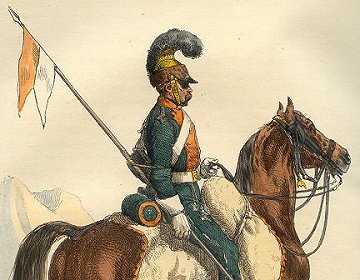 French author St.Hilaire wrote about Napoleonic lances: "The Polish lancer, as well as the French lancer distinguished
himself by his elegant appearance; but the looks of this last were softer and the colors of his origin moderated,
in respect to the military roughness of the first figure. As brave as the Polish lancer, the French lancer had a lively mood; he was more sober especially
in his way of living, while the intemperance of Polish had become proverbial in the army."
French author St.Hilaire wrote about Napoleonic lances: "The Polish lancer, as well as the French lancer distinguished
himself by his elegant appearance; but the looks of this last were softer and the colors of his origin moderated,
in respect to the military roughness of the first figure. As brave as the Polish lancer, the French lancer had a lively mood; he was more sober especially
in his way of living, while the intemperance of Polish had become proverbial in the army."
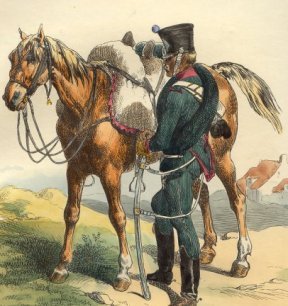 In 1798 the Directorate had 22 regiments of chasseurs but Napoleon increased their numbers.
In 1804 were already 24 regiments, in 1811 as many as 31 regiments. Only in 1815 were 15 regiments. There were several reasons why the Emperor formed so many units of chasseurs. Their uniforms were cheaper than hussars', their horses cheaper than cuirassiers'.
They were capable of dismounted action (like dragoons) and were suited to reconnaissance duties (like the hussars). Some regiments were also trained for several months (at least in 1805) to handle the guns. But according to Charles Parquin of 20e Chasseurs "we never had the opportunity of using the talent which we acquired."
Many of chasseurs were reckless bravados - in one of the battles of 1809 an officer of 20e
Chasseurs dismounted so that he could go a little toward the enemy in order to relieve nature.
When he was standing with his legs apart and facing the Austrians, a cannonball hit
him killing on the spot. In 20e served Charles Parquin, in 23e was Marbot, both wrote
interesting and enterteining memoirs. In 1805 at Austerlitz 5e and 26e Chasseurs captured
Allies flags. They were able to fight dismounted. In 1809 "The Emperor mounted a hillock a close to the village, from whose gardens a dozne or so shots were fired in our direction.
A squadron of chasseurs-a-cheval were riding close behind the Emperor (for the Guard chasseurs were still far to the rear).
The Emperor ordered me to take this squadron and clear the village. The chasseurs advanced rapidly, ignoring the enemy fire,
dismounted and closed with the enemy. A few hundred Austrians surrendered." (Chlapowski - "memoirs of a Polish Lancer" p 60,
transl. by Tim Simmons)
In 1798 the Directorate had 22 regiments of chasseurs but Napoleon increased their numbers.
In 1804 were already 24 regiments, in 1811 as many as 31 regiments. Only in 1815 were 15 regiments. There were several reasons why the Emperor formed so many units of chasseurs. Their uniforms were cheaper than hussars', their horses cheaper than cuirassiers'.
They were capable of dismounted action (like dragoons) and were suited to reconnaissance duties (like the hussars). Some regiments were also trained for several months (at least in 1805) to handle the guns. But according to Charles Parquin of 20e Chasseurs "we never had the opportunity of using the talent which we acquired."
Many of chasseurs were reckless bravados - in one of the battles of 1809 an officer of 20e
Chasseurs dismounted so that he could go a little toward the enemy in order to relieve nature.
When he was standing with his legs apart and facing the Austrians, a cannonball hit
him killing on the spot. In 20e served Charles Parquin, in 23e was Marbot, both wrote
interesting and enterteining memoirs. In 1805 at Austerlitz 5e and 26e Chasseurs captured
Allies flags. They were able to fight dismounted. In 1809 "The Emperor mounted a hillock a close to the village, from whose gardens a dozne or so shots were fired in our direction.
A squadron of chasseurs-a-cheval were riding close behind the Emperor (for the Guard chasseurs were still far to the rear).
The Emperor ordered me to take this squadron and clear the village. The chasseurs advanced rapidly, ignoring the enemy fire,
dismounted and closed with the enemy. A few hundred Austrians surrendered." (Chlapowski - "memoirs of a Polish Lancer" p 60,
transl. by Tim Simmons)
 One of the most known chasseurs was Montbrun. Louis-Pierre Montbrun (1770-1812) joined the
cavalry in 1789 in the age of 19. According to Terry J. Senior of napoleon-series.org
"This soldier was a superb equestrian, with a brilliant sword arm, and a terrific combat
record. He possessed an exceptional talent for controlling large formations of mixed cavalry.
Rated ahead of LaSalle on the basis that he was less headstrong and more calculating than the
legendary hussar commander."
Elting writes: "Montbrun was a worthy comrade. Very tall, scarred,
and soldierly, with an eye that compelled obedience, active and tireless, he had risen
from private to colonel of the 1st Chasseurs-a-Cheval. Davout got him promoted to general
of brigade. He was at once prudent and reckless, careful of the lives of his men yet a
driving, aggressive leader. In August 1812 he was suffering an attack of gout when the
Russians attempted a counteroffnsive; unable to pull on his boots, he rode to the rescue
in his stocking feet. A month later at
One of the most known chasseurs was Montbrun. Louis-Pierre Montbrun (1770-1812) joined the
cavalry in 1789 in the age of 19. According to Terry J. Senior of napoleon-series.org
"This soldier was a superb equestrian, with a brilliant sword arm, and a terrific combat
record. He possessed an exceptional talent for controlling large formations of mixed cavalry.
Rated ahead of LaSalle on the basis that he was less headstrong and more calculating than the
legendary hussar commander."
Elting writes: "Montbrun was a worthy comrade. Very tall, scarred,
and soldierly, with an eye that compelled obedience, active and tireless, he had risen
from private to colonel of the 1st Chasseurs-a-Cheval. Davout got him promoted to general
of brigade. He was at once prudent and reckless, careful of the lives of his men yet a
driving, aggressive leader. In August 1812 he was suffering an attack of gout when the
Russians attempted a counteroffnsive; unable to pull on his boots, he rode to the rescue
in his stocking feet. A month later at  On picture: robust hussar of Lasalle's "Hellish Brigade"
On picture: robust hussar of Lasalle's "Hellish Brigade"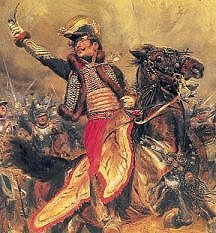 The most famous hussar commander was General Antoine-Charles Lasalle, "the man for high adventure
and reckless deeds. In 1806 after the Battle of Jena, with only 900 hussars at his back and no weapon heavier than their
popgun carbines, he bluffed the great fortress of Stettin, with 200 guns and a garrison of 5,000 men, into surrender.
... He had no enemies and rode with open heart and open hand. Utterly brave, loving danger, laughing at his own
hardships, frequently charging with a long pipe instead of a saber in his hand, he had too much heart
and too little head to handle masses of cavalry, and so got himself uselessly killed at the end of day at Wagram ...
His trick of the trade was to charge at the trot, holding his men solidly in hand to meet an enemy exhausted from galloping."
(Elting, - p 163)
The most famous hussar commander was General Antoine-Charles Lasalle, "the man for high adventure
and reckless deeds. In 1806 after the Battle of Jena, with only 900 hussars at his back and no weapon heavier than their
popgun carbines, he bluffed the great fortress of Stettin, with 200 guns and a garrison of 5,000 men, into surrender.
... He had no enemies and rode with open heart and open hand. Utterly brave, loving danger, laughing at his own
hardships, frequently charging with a long pipe instead of a saber in his hand, he had too much heart
and too little head to handle masses of cavalry, and so got himself uselessly killed at the end of day at Wagram ...
His trick of the trade was to charge at the trot, holding his men solidly in hand to meet an enemy exhausted from galloping."
(Elting, - p 163)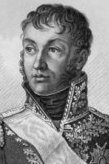 The Colonel-General of Hussars was General Andoche Junot. He gave Napoleon absolute loyalty,
his whirlwind bravery earned him the nickname "the Tempest." Junot however was becoming
erratic, the result of several head wounds.
The Colonel-General of Hussars was General Andoche Junot. He gave Napoleon absolute loyalty,
his whirlwind bravery earned him the nickname "the Tempest." Junot however was becoming
erratic, the result of several head wounds.
 On picture: charging hussar. Maughan - "Napoleon's Cavalry
Recreated in Color Photographs".
On picture: charging hussar. Maughan - "Napoleon's Cavalry
Recreated in Color Photographs".